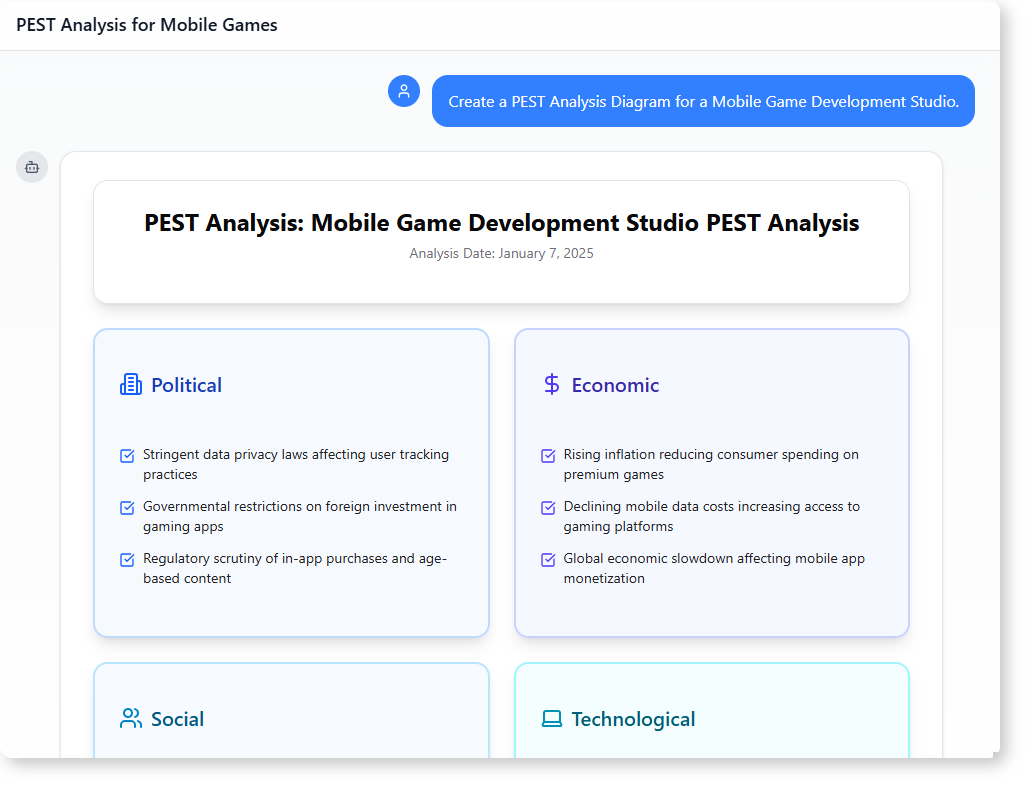Now Reading: How to Create a PEST Analysis for a Mobile Game Studio with AI-Powered Modeling Software
-
01
How to Create a PEST Analysis for a Mobile Game Studio with AI-Powered Modeling Software
How to Create a PEST Analysis for a Mobile Game Studio with AI-Powered Modeling Software
Why a Mobile Game Studio Needs a PEST Analysis
Running a mobile game studio involves navigating a complex ecosystem of external forces. Market trends, regulatory changes, and consumer behavior can shift rapidly—often without warning.
A PEST analysis helps identify these factors early. For a mobile game studio, understanding political, economic, social, and technological influences is essential to planning game features, monetization, and long-term strategy.
That’s where AI-powered modeling software steps in. It doesn’t just generate a PEST diagram—it contextualizes each factor with real-world relevance.

A Real-World Use Case: From Prompt to PEST Analysis
Imagine a mobile game studio preparing for a new game release. The team needs to assess external risks and opportunities before investing in design or monetization.
Instead of manually researching each factor, the team turns to AI-powered modeling software.
Step 1: The User Defines the Objective
The project manager opens the AI chat interface and types:
“Create a PEST Analysis Diagram for a Mobile Game Development Studio.”
The AI immediately responds with a structured PEST diagram. It organizes the key external forces into four categories—Political, Economic, Social, and Technological—each with specific, actionable insights.
Step 2: The AI Generates Insightful, Contextual Factors
The generated PEST analysis includes:
- Political: Stringent data privacy laws affecting user tracking practices, governmental restrictions on foreign investment in gaming apps, and regulatory scrutiny of in-app purchases and age-based content.
- Economic: Rising inflation reducing consumer spending on premium games, declining mobile data costs increasing access to gaming platforms, and global economic slowdown affecting mobile app monetization.
- Social: Growing demand for inclusive and diverse character representation, shift in player preferences toward free-to-play with microtransactions, and increased focus on mental health and screen time in youth demographics.
- Technological: Rapid advancement in cloud-based game hosting and scalability, AI-driven content generation for dynamic in-game environments, and expansion of 5G and edge computing enabling smoother gameplay.
Each point is not just a fact—it’s framed in a way that directly impacts game design decisions. For example, concerns about screen time trigger a need for age-based content warnings, while rising inflation pushes the studio toward free-to-play models.
Step 3: The Team Explores the Full Picture
After reviewing the diagram, the project lead asks the AI to convert it into a formal research-style report with supporting explanations.
The AI generates a detailed report that explains:
- How data privacy laws affect user data collection and in-app tracking.
- Why inflation reduces demand for premium games.
- Why players now expect diverse characters and mental health considerations.
- How AI and 5G can improve gameplay scalability and immersion.
This isn’t just a list of factors. It’s a strategic narrative that positions each element as a decision point for the studio.
What Makes This AI-Powered Modeling Software Different
Traditional PEST analysis tools require hours of manual research and formatting. They often deliver generic, disconnected points.
This AI-powered modeling software delivers:
- Immediate, context-aware insights tailored to the industry.
- A clear visual structure that maps external forces to real business decisions.
- Natural language explanations that go beyond definitions—providing strategic implications.
It doesn’t just generate a PEST diagram. It helps teams see how one change—like a new privacy law—might ripple through game design, monetization, and user acquisition.
Why This Matters for Game Studios
For a mobile game studio, every decision has a cost. A missed trend can cost millions. An overlooked social factor might lead to poor player engagement.
With AI-powered modeling software, teams can:
- Spot emerging risks before they become crises.
- Align game features with market expectations.
- Make faster, data-informed decisions during development.
It turns strategic planning from a guesswork process into a structured, insightful workflow.
Frequently Asked Questions
How does AI-powered modeling software help with PEST analysis?
It transforms abstract external factors into specific, actionable insights. For a mobile game studio, this means understanding how inflation, privacy laws, or player preferences will affect design and monetization.
Can the AI generate a report from a PEST diagram?
Yes. After creating the diagram, users can prompt the AI to generate a formal, research-style report with detailed explanations for each factor.
Is the PEST analysis generated based on real-world data?
The insights are derived from industry trends and documented market shifts. While not live data, they reflect real patterns observed in the gaming and tech sectors.
What if my studio is in a different market?
The AI adapts the analysis to the context. For example, a mobile game studio in a region with strong data regulations will get stronger emphasis on privacy-related factors.
Ready to map out your strategy’s external forces? Give our AI-powered modeling software a try at Visual Paradigm’s AI Chatbot today!
